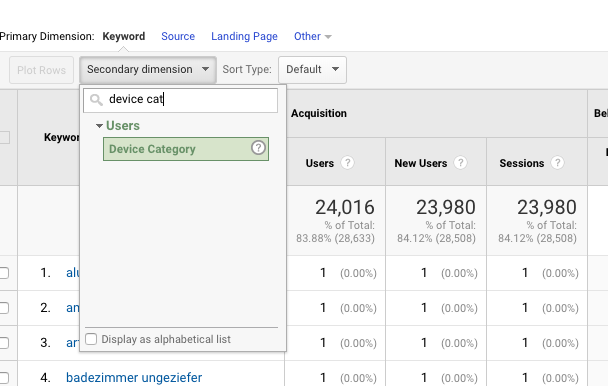Exactly How to Make Use Of Secondary Dimension in Google Analytics for Deeper Insights
Exactly How to Make Use Of Secondary Dimension in Google Analytics for Deeper Insights
Blog Article
Maximize Coverage Accuracy With Second Dimension in Google Analytics
Understanding exactly how to maximize reporting precision with secondary dimensions in Google Analytics can significantly enhance the depth of insights acquired from data analysis. By integrating second dimensions tactically, marketing professionals can reveal covert patterns and connections that might not be promptly noticeable when evaluating key metrics alone. This nuanced method allows a much more comprehensive understanding of user habits and project efficiency, leading the way for more targeted and efficient decision-making. The application of secondary dimensions holds the crucial to opening a wide range of important details that can change the efficiency of digital advertising strategies.
Understanding Additional Measurements in Google Analytics
Additional measurements allow individuals to sector and better dissect information past the main dimension picked. While the primary dimension may show the overall number of page sights, adding a secondary dimension such as 'source/medium' can provide insights into where the traffic stemmed from.
Furthermore, comprehending additional measurements is essential for creating much more customized records tailored to details organization objectives. By choosing the right combination of additional and main dimensions, analysts can reveal patterns, trends, and correlations that might or else continue to be covert. This nuanced technique to information analysis equips businesses to make informed choices based on a detailed understanding of individual habits across different dimensions.

How to Apply Second Measurements
When leveraging additional measurements in Google Analytics, the practical application includes picking certain information criteria to additional fine-tune understandings past the primary measurement's extent. To use secondary dimensions successfully, start by accessing the record or dataset where you desire to dive much deeper into the data. Remember that additional dimensions assist give context and granularity to your primary dimension information, enabling you to extract more purposeful and workable insights from your Google Analytics reports.
Leveraging Second Measurements for Insights
Utilizing second measurements in Google Analytics allows for a more thorough analysis of data, offering useful insights beyond the key dimension's scope. By leveraging secondary measurements, customers can dig deeper right into the performance metrics of their website or application, discovering hidden patterns and patterns that may not be quickly noticeable when only taking a look at main dimensions.
One key advantage of making use of second measurements is the capacity to section and filter information much more precisely. This can help experts and online marketers much better comprehend the habits of certain individual sections, such as brand-new visitors versus returning site visitors, or web traffic originating from various geographic areas.
In addition, additional measurements allow individuals to contrast and comparison numerous data points within the very same record, providing a much more holistic view of performance (Secondary Dimension in Google Analytics). As an example, matching the key dimension of touchdown pages with additional dimensions like gadgets or demographics can reveal which pages are most efficient in involving customers on different tools or from different demographic groups.
Basically, leveraging additional measurements in Google Analytics equips users to draw out richer insights from their data, leading to more enlightened decision-making and eventually, improved performance.
Best Practices for Additional Measurements
When assessing data in Google Analytics, integrating second measurements efficiently boosts the deepness of insights acquired from the main metrics. To make one of the most out of additional dimensions, it is critical to abide by best methods that guarantee significant and accurate coverage. First of all, it is essential to select second measurements that line up with the primary metric you are assessing. Selecting pertinent additional measurements aids in providing context and a more clear understanding of the data being taken a look at.
In addition, it is recommended to limit the variety of additional measurements used in a solitary record to stay clear of frustrating the analysis with way too much info. Concentrating on a couple of vital secondary dimensions each time can cause even more workable and concentrated understandings. Additionally, consider exploring with different combinations of main and additional measurements to reveal unique trends and patterns that may check this site out not be evident when taking a look at the information in isolation.
Advanced Evaluation Strategies With Secondary Dimensions
Exploring elaborate data connections with the calculated application of secondary dimensions can unveil nuanced insights that boost the deepness of analysis in Google Analytics. By combining secondary measurements with primary data collections, advanced evaluation techniques can be used to extract beneficial info.
Furthermore, second dimensions can boost the evaluation of conversion paths by offering additional context. Recognizing the different touchpoints a user interacts with before transforming can be crucial in optimizing the customer journey - Secondary Dimension in Google Analytics. By making use of secondary measurements to explore specifics such as website traffic sources or gadgets used, online marketers can customize strategies to target high-converting networks efficiently
Verdict

To enhance data evaluation and gain deeper insights into user actions, recognizing additional dimensions in Google Analytics is essential - Secondary Dimension in Google Analytics. Additional dimensions enable users to segment and additionally study information past the main dimension picked. While the key dimension may display the total number of web page sights, including a secondary dimension such as 'source/medium' can give insights right into where the web traffic originated from.When leveraging secondary measurements in Google Analytics, the practical application involves choosing certain data criteria visit this website to additional fine-tune insights beyond the main dimension's range. Bear in mind that second measurements help offer context and granularity to your main dimension data, allowing you to draw out next page more meaningful and workable insights from your Google Analytics reports
Report this page